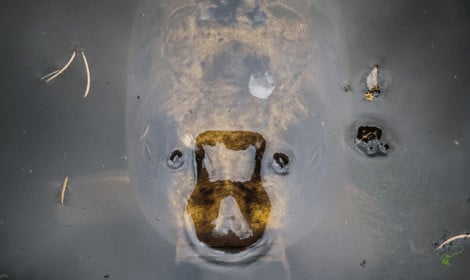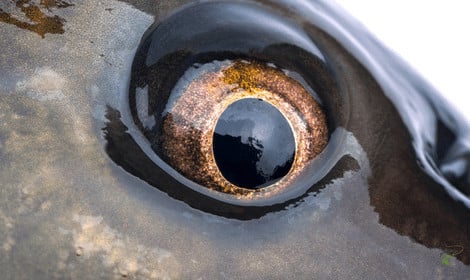
If you want to become a highly experienced carp angler who wants to put fish in the net consistently, then you will need to develop a complete understanding of the carp you are hoping to catch.
The most experienced anglers learn not only the best rigs, baits, watercraft and baiting approaches but also the make-up and behaviours of the fish swimming below us.
In this post, I’m going to dive into how carp see and how they primarily find food.
How Do Carp See?

Carp have decent eyesight and coloured vision from two eyes above and behind their large, downturned mouth used for bottom feeding.
Their eyes are used for spotting predators in their infantile stage, avoiding anglers, and locating food throughout their life span. Their eyesight is not their most effective sense for finding food.
I’ll cover how carp find their food further through this post.
When the water is murky or silty, light penetration from the surface is highly reduced, and the fish will have difficulty seeing long distances underwater with their eyes.
Water in lakes and fishing venues generally becomes murky after high levels of rainfall as lots of silt and mud is washed into the water from the surrounding area.
Carp also sift through the silt and mud on the bottom of the water, looking for food which causes the silt and mud to agitate up into the water, making it cloudy and reducing their vision.
On the other hand, on bright sunny days or in clear water, the carp will have no issues locating food and swimming comfortably as they can see well.
If the carp swim in really deep water, their eyesight is reduced the further they swim due to high levels of light not penetrating to the bottom.
Do Carp Have Blind Spots?
As the carp’s eyes are on the side of their head, they have a very wide angle of vision, but this also gives them a small blind spot.
These blind spots are close to either side of their body and directly behind them.
Although they only have a small blind spot where they can’t see anything, not all of their vision is the full definition.
They have large areas of monocular vision to the side of their bodies. Monocular vision is seeing movements but not focusing on objects to see them clearly.
This vision is all the carp need as they can position their body to see these areas clearly or can move quickly if they spot movement in these areas.
How Far Can Carp See?
Due to carp eyes being at the sides and near the top of their head, they are far more suited for seeing objects at close range.
Due to the position of their eyes, they struggle with judging distances. This is where their other sense comes into play for pinpointing where the food source is.
Can Carp See In the Dark?
Believe it or not, carp are far better at seeing in the dark than us humans. This could explain why carp will commonly be most active at dusk and dawn when light levels change.
To explain this, I’ll need to explain a little about how our eyes work so you can gain a brief understanding of how carp have better vision in the dark..
As humans, we have three “cone cells” that register different colour shades and allow us to see.
Carp have four cone cells that allow them to see red, green, blue and ultraviolet light, which is more than humans.
The fact that carp can see a broader spectrum of light allows them to see far better in the dark and in fairly dirty water. So don’t rule out carp fishing at night as you don’t think the carp will be able to see.
As water absorbs different colours of light at different rates, the carp’s sight is set up to see the light better on the blue end of the spectrum, which also helps with their vision at night.
How does Carp Find Food?
Although carp sometimes use their vision to find food under the water, this is not their main and most effective method of finding food.
To explain this, I’ll add a small part from one of my other posts focused on how carp feed.
“Carp are great foragers and use various methods for scouring for food in every layer of water. Just because carp are bottom feeders, they don’t necessarily always feed on the bottom.
Carp use their sense of smell, eyesight and even an olfactory system that lets them sense any dissolved foodstuff in the water.
The carp use the following method for sourcing food;
- Barbels – Two barbels protrude from the side of the carp’s mouth, with two smaller barbels above the mouth. These are not just for show and are used to detect food on the bottom of the lake directly under its mouth where it can’t quite see. These barbels also have taste buds that quickly detect if the item they are touching is edible or not.
- Mouth – Carp have an excellent sense of taste as their mouths have chemical-sensitive cells that determine whether a food substance is edible. Carp actually expel around 97% of what they take into their mouth for tasting.
- Pectoral and Pelvic Fins – The carp’s fins are lined by taste buds that further aid in finding food sources close to the fish.
- Eyes – These fish have excellent vision, with two eyes on either side of the head. This vision is used not only to look for predators, anglers on the banks included, they also use them for sourcing food. This is why brightly coloured baits seem to work well as the carp’s attention is drawn to them.
- Olfactory System – The olfactory system allows the fish to sense dissolved substances in the water such as salts, sugars and proteins in baits that help to bring carp in from the surrounding area to your baits.”
That’s All
Carp can see fairly well and use their eyes to spot predators, including anglers, for moving around and also a part in locating food.
Everyone angler will know that carp can see to some degree, but most don’t know that their sight is not the main method for finding food.
You should now have a good idea of how carp see and how it has some influence on your fishing approach.


